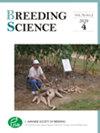籼稻(<i>Oryza sativa</i>)遗传背景下携带抗褐飞虱基因的金字塔系的发育L.品种“IR64”
IF 2.2
4区 农林科学
Q2 AGRONOMY
引用次数: 0
摘要
抗性水稻品种的培育是生态防治褐飞虱的关键策略之一。然而,由于田间有毒菌株的进化和对BPH的单基因抗性的迅速破坏,BPH暴发经常发生。因此,为了提高BPH抗性并评估基因金字塔对强毒BPH的有效性,我们在“IR64”遗传背景下培育了携带BPH抗性基因的金字塔系(pyl)。我们通过标记辅助选择获得了6个ir64 - pyl (BPH3 + BPH17、BPH32 + BPH17、BPH32 + BPH20、BPH3 + BPH17-ptb、BPH20 + BPH3和BPH17-ptb + BPH32)。为了评估ir64 - pyl的抗性,我们利用强毒BPH群体进行了抗生素试验、蜜露试验和改良种箱筛选试验(MSST)。与相比,所有6个IR64- pyl的BPH抗性水平都有所增加,同时在MSST中,IR64和相应的NILs都有所增加。其中,IR64-BPH3 + BPH17和IR64-BPH32 + BPH17对BPH的抗性最强。然而,在抗生素试验中,大多数ir64 - pyl的耐药水平并不显著高于相应的NILs。因此,这些pyl可以作为育种计划的宝贵资源,旨在提高对BPH毒株的抗性和增强其持久性。本文章由计算机程序翻译,如有差异,请以英文原文为准。
Development of pyramided lines carrying brown planthopper resistance genes in the genetic background of Indica Group rice (<i>Oryza sativa</i> L.) variety ‘IR64’
The development of resistant rice (Oryza sativa L.) varieties is a key strategy for the eco-friendly control of brown planthopper (BPH: Nilaparvata lugens Stål). However, BPH outbreaks occur frequently owing to the evolution of virulent strains in the field and the rapid breakdown of monogenic resistance to BPH. Therefore, to enhance BPH resistance and gauge the effectiveness of gene pyramiding against strongly virulent BPH, we developed pyramided lines (PYLs) in the genetic background of ‘IR64’ carrying BPH resistance genes. We developed six IR64-PYLs (BPH3 + BPH17, BPH32 + BPH17, BPH32 + BPH20, BPH3 + BPH17-ptb, BPH20 + BPH3, and BPH17-ptb + BPH32) through marker-assisted selection. To assess the resistance of the IR64-PYLs, we conducted antibiosis test, honeydew test, and modified seedbox screening test (MSST) using strongly virulent BPH populations. The level of BPH resistance increased in all six IR64-PYLs compared to both ‘IR64’ and the corresponding NILs in MSST. Among them, IR64-BPH3 + BPH17 and IR64-BPH32 + BPH17 exhibited the highest resistance to BPH. However, the resistance level of most IR64-PYLs was not significantly higher than that of the corresponding NILs in antibiosis test. Thus, these PYLs could serve as a valuable resource for breeding programs aimed at improving resistance to virulent strains of BPH and enhancing their durability.
求助全文
通过发布文献求助,成功后即可免费获取论文全文。
去求助
来源期刊

Breeding Science
农林科学-农艺学
CiteScore
4.90
自引率
4.20%
发文量
37
审稿时长
1.5 months
期刊介绍:
Breeding Science is published by the Japanese Society of Breeding. Breeding Science publishes research papers, notes and reviews
related to breeding. Research Papers are standard original articles.
Notes report new cultivars, breeding lines, germplasms, genetic
stocks, mapping populations, database, software, and techniques
significant and useful for breeding. Reviews summarize recent and
historical events related breeding.
Manuscripts should be submitted by corresponding author. Corresponding author must have obtained permission from all authors
prior to submission. Correspondence, proofs, and charges of excess page and color figures should be handled by the corresponding author.
 求助内容:
求助内容: 应助结果提醒方式:
应助结果提醒方式:


